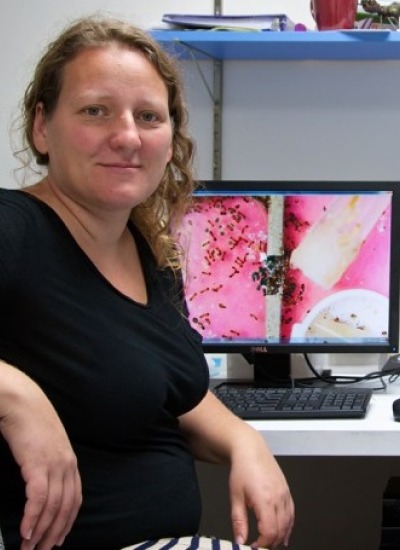Anna R Dornhaus
Publications
Abstract:
Social insects are distinguished by their extraordinary degree of cooperation and the complexity of their group organization. However, a high proportion of individuals (often >50% at any one time) in a social insect colony tend to be inactive. It has been hypothesized that larger colonies can afford such inactivity because of efficiencies gained through stronger division of labor. We quantify the degree to which colonies of different sizes exhibit division of labor, and what proportion tends to be inactive, in the ant Temnothorax albipennis. Colony size neither influenced individual specialization nor overall division of labor in this species and larger colonies did not show a higher proportion of inactive workers. Interestingly, small colonies seemed to rely more on a small number of high-performance workers: the proportion of work performed by the single most active worker is significantly higher in smaller colonies for several tasks. More research is needed to resolve when and how colony size affects collective organization and division of labor in insect colonies.
PMID: 21888521;Abstract:
Many insects and arthropods live in colonies or aggregations of varying size. Group size may affect collective organization either because the same individual behavior has different consequences when displayed in a larger group or because larger groups are subject to different constraints and selection pressures than smaller groups. In eusocial colonies, group size may have similar effects on colony traits as body size has on organismal traits. Social insects may, therefore, be useful to test theories about general principles of scaling, as they constitute a distinct level of organization. However, there is a surprising lack of data on group sizes in social insects and other group-living arthropods, and multiple confounding factors have to be controlled to detect effects of group size. If such rigorous studies are performed, group size may become as important to understanding collective organization as is body size in explaining behavior and life history of individual organisms. © 2012 by Annual Reviews. All rights reserved.
PMID: 21625450;PMCID: PMC3098866;Abstract:
Background: An important function of many complex networks is to inhibit or promote the transmission of disease, resources, or information between individuals. However, little is known about how the temporal dynamics of individual-level interactions affect these networks and constrain their function. Ant colonies are a model comparative system for understanding general principles linking individual-level interactions to network-level functions because interactions among individuals enable integration of multiple sources of information to collectively make decisions, and allocate tasks and resources. Methodology/Findings: Here we show how the temporal and spatial dynamics of such individual interactions provide upper bounds to rates of colony-level information flow in the ant Temnothorax rugatulus. We develop a general framework for analyzing dynamic networks and a mathematical model that predicts how information flow scales with individual mobility and group size. Conclusions/Significance: Using thousands of time-stamped interactions between uniquely marked ants in four colonies of a range of sizes, we demonstrate that observed maximum rates of information flow are always slower than predicted, and are constrained by regulation of individual mobility and contact rate. By accounting for the ordering and timing of interactions, we can resolve important difficulties with network sampling frequency and duration, enabling a broader understanding of interaction network functioning across systems and scales. © 2011 Blonder, Dornhaus.
Abstract:
Why do some social insects have sophisticated recruitment systems, while other species do not communicate about food source locations at all? To answer this question, it is necessary to identify the social or ecological factors that make recruitment adaptive and thus likely to evolve. We developed an individual-based model of honey bee foraging to quantify the benefits of recruitment under different spatial distributions of nondepleting resource patches and with different colony sizes. Benefits of recruitment were strongly dependent on resource patch quality, density, and variability. Communication was especially beneficial if patches were poor, few, and variable. A sensitivity analysis of the model showed that under conditions of high resource density recruitment could even become detrimental, especially if foraging duration was short, tendency to scout was high, or recruits needed a long time to find communicated locations. Colony size, a factor often suspected to influence recruitment evolution, had no significant effect. These results may explain the recent experimental findings that in honey bees, benefits of waggle dance recruitment seem to vary seasonally and with habitat. They may also explain why some, but not other, species of social bees have evolved a strategy to communicate food locations to nest mates.
Pagination
- First page
- …
- 12
- 13
- 14
- …
- Last page


